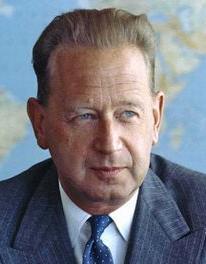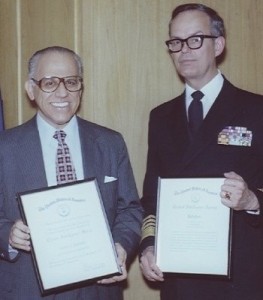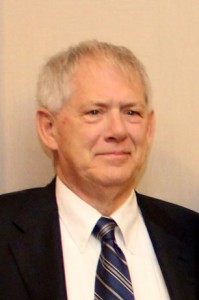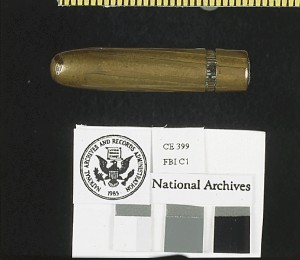by Lisa Pease
From the Archive: In reopening the investigation into the mysterious plane crash that killed UN Secretary General Dag Hammarskjold in 1961, the United Nations is appealing to member states to release long-secret files related to this cold case from a tense moment in the Cold War in Africa, which Lisa Pease examined in 2013.
By Lisa Pease, March 17, 2015 (Originally published on Sept. 16. 2013, https://consortiumnews.com/2015/03/17/the-mysterious-death-of-a-un-hero-2/ )
More than a half century ago, just after midnight on Sept. 18, 1961, the plane carrying UN Secretary-General Dag Hammarskjöld and 15 others went down in a plane crash over Northern Rhodesia (now Zambia). All 16 died, but the facts of the crash were provocatively mysterious.
There have been three investigations into the crash: an initial civil aviation Board of Inquiry, a Rhodesian Commission of Inquiry, and a UN Commission in 1962. Not one of them could definitively answer why the plane crashed or whether a deliberate act had been responsible.
While a few authors have looked into and written about the strange facts of the crash in the years since the last official inquiry in 1962, none did a more thorough reinvestigation than Dr. Susan Williams, a Senior Fellow at the Institute of Commonwealth Studies at the University of London, whose book Who Killed Hammarskjöld? was released in 2011, 50 years after the crash.
Her presentation of the evidence was so powerful it launched a new UN commission to determine whether the UN should reopen its initial investigation. “It is a fact,” the current Commission wrote in its report, “that none of these inquiries was conducted to the standard to which a modern inquiry into a fatal event would be conducted….”
The Commission was formed by Lord Lea of Crondall, who assembled a group of volunteer jurists, solicitors and others from the Netherlands, South Africa, Sweden and elsewhere to tabulate and review the evidence the Commission collected from past investigations, Williams’s book, and independent witnesses, such as myself.
I was one of the 28 witnesses (and one of only three Americans) who provided testimony to the Commission, based on information gathered in the course of my research into the assassinations of the Sixties.
“It is legitimate to ask whether an inquiry such as this, a full half-century after the events with which it is concerned, can achieve anything except possibly to feed speculation and conspiracy theories surrounding the crash,” the most recent Commission wrote in its report.
“Our answer, and the reason why we have been willing to give our time and effort to the task, is first that knowledge is always better than ignorance, and secondly that the passage of time, far from obscuring facts, can sometimes bring them to light.”
The Congo Crisis
The report summarized the historical situation Hammarskjöld was faced with in 1961. In June of 1960, under pressure from forces in the Congo as well as from the United 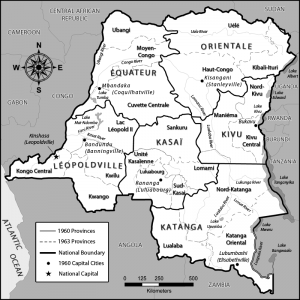 Nations, Belgium had relinquished its claim to the Congo, a move which brought Patrice Lumumba to power.
Nations, Belgium had relinquished its claim to the Congo, a move which brought Patrice Lumumba to power.
Lumumba faced a near civil war in his country immediately. The military mutinied, the Belgians stepped back in to protect Belgian settlers, and local leader Moise Tshombe declared Katanga, a mineral-rich province, an independent state.
As the Commission’s report noted, “Katanga contained the majority of the Congo’s known mineral resources. These included the world’s richest uranium and four fifths of the West’s cobalt supply. Katanga’s minerals were mined principally by a Belgian company, the Union Minière du Haut Katanga, which immediately recognised and began paying royalties to the secessionist government in Elisabethville. One result of this was that Moise Tshombe’s regime was well funded. Another was that, so long as Katanga remained independent of the Congo, there was no risk that the assets of Union Minière would be expropriated.”
The U.S. government feared that Katanga’s rich uranium reserves would fall under Soviet control if the nationalist movement that brought Lumumba to power succeeded in unifying the country. Indeed, rebuffed by Western interests, Lumumba did reach out to the Soviets for help, a move that caused CIA Director Allen Dulles to initiate CIA plans for Lumumba’s assassination. Lumumba was ultimately captured and killed by forces of Joseph Mobutu, whom Andrew Tully called “the CIA’s man” in the Congo just days before President Kennedy’s inauguration.
On the southern border of Katanga lay Northern Rhodesia, where Hammarskjöld’s plane would eventually go down, Sir Roy Welensky, a British politician, ruled as prime minister. Welensky, too, pushed for an independent Katanga. Along with the resources, there was also the fear that an integrated Congo and Katanga could lead to the end of apartheid in Rhodesia which might spread to its larger and more prosperous neighbor South Africa.
The British situation was divided, with the Under-Secretary of State for Foreign Affairs, Lord Landsdowne, backing the UN’s efforts at preserving a unified Congo, while the British High Commissioner to the Rhodesian Foundation, Lord Alport, was upset with the UN’s meddling, saying African issues were “better left to Europeans with experience in that part of the world.”
Similarly, U.S. policy appeared split in 1961. Allen Dulles and possibly President Dwight D. Eisenhower had worked to kill Lumumba just before President John F. Kennedy took office. But President Kennedy had been a supporter of Lumumba and fully backed the UN’s efforts in the Congo.
As the report notes, “There is evidence … of a cleft in policy between the US Administration and the US Central Intelligence Agency. While the policy of the Administration was to support the UN, the CIA may have been providing materiel to Katanga.”
So British, Belgian and American interests that weren’t always representative of their official heads of state had designs on Katanga, its politics and its resources. What stood in their way? The UN, under the firm leadership of Dag Hammarskjöld.
The UN forces had been unsuccessful in unifying the Congo, so Hammarskjöld and his team flew to Leopoldville on Sept. 13, 1961. Hammarskjöld planned to meet Tshombe to discuss aid, contingent on a ceasefire, and the two decided to meet on Sept. 18 in Ndola in Northern Rhodesia (now Zambia).
On Sept. 17, the last day of Hammarskjöld’s life, Neil Ritchie, an MI6 officer, went to pick up Tshombe and the British consul in Katanga, Denzil Dunnett. He found them in the company of a high-level Union Minière employee.
That night, Hammarskjöld embarked on the Albertina, a DC6 plane, and flew from Leopoldville to Ndola, where he was to arrive shortly after midnight. Lord Landsdowne, the British leader opposing a unified Congo, flew separately, although the report goes out of its way to say there was nothing sinister in them flying in separate planes and that this was “diplomatically and politically appropriate.”
A large group of diplomats, Africans, journalists and at least three mercenaries waited for Hammarskjöld’s plane at the Ndola airport. The Commission found the presence of mercenaries there strange as a police inspector was on duty specifically “to ensure nobody was at the airport who had no good reason to be there.”
The Crash
Hammarskjöld’s plane deliberately circumvented Katanga, fearing interception. The pilot radioed Ndola 25 minutes before midnight with an estimate that they plane was about 45 minutes from landing. At 12:10 a.m., the pilot notified the Ndola airport “Your lights in sight” and requested confirmation of the air pressure reading (QNH). “Roger QNH 1021mb, report reaching 6000 feet,” the airport replied. “Roger 1021,” the Albertina responded. That was the last communication received from Hammarskjöld’s plane. It crashed within minutes.
The Commission found the airport gave the plane correct information, that there was no indication the plane’s altimeter had been tampered with, that the landing gear had been lowered into the proper position and locked, and that the wing flaps had been correctly set. In other words, pilot error — the verdict of the initial Rhodesian inquiry into Dag Hammarskjöld’s death in 1962 — did not seem to be the likely cause.
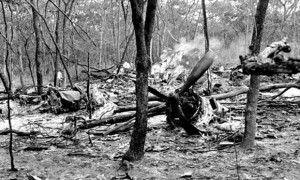
The wreckage of the plane carrying Dag Hammarskjöld in a forest near Ndola in what is now Zambia. Photograph: AP
At the crash site, several of the crash victims had bullets in their bodies. In addition, the Commission found “evidence from more than one source…that holes resembling bullet-holes were observed in the burnt-out fuselage.”
The Commission’s two aviation experts concluded the most likely cause of the crash seemed to be a “controlled flight into terrain,” meaning, no in-air explosion. This suggests someone deliberately or mistakenly drove the plane right into the ground. However, the report notes, this does not rule out some form of sabotage that could have distracted or injured the pilots, preventing a successful landing.
And the Commission noted contradictory evidence from a few eyewitnesses who claimed they saw the plane explode in mid-air. Another eyewitness, a member of the flight crew, found alive but badly burned, told a police inspector that the plane “blew up” and that “There was a lot of small explosions all around.”
The Commission interviewed African eyewitnesses who had feared coming forward years ago. One of them described seeing the plane on fire before it hit the ground. Another described seeing a “ball of fire coming on top of the plane.” Still another described a “flame … on top of the plane … like a ball of fire.”
Several witnesses saw a second plane near the one that crashed. One witness saw a second, smaller plane following a larger one, and told the Commission, “I saw that the fire came from the small plane…” And another witness also recalled seeing two planes in the sky with the larger one on fire. A third witness noted that he saw a flash of flame from one plane strike another. Several witnesses reported two smaller planes following a larger one just before the larger one caught fire.
A Swedish flight instructor described in 1994 how he had heard dialog via a short-wave radio the night of the crash. He recalled hearing the following from an airport control tower at the time of the crash: “He’s approaching the airport. He’s turning. He’s leveling. Another plane is approaching from behind — what is that?”
In one of the more bizarre elements of the case, Hammarskjöld’s body was not burnt, yet the other victims of the crash were severely burnt. The Commission concluded the most likely explanation, though not the sole one, was that Hammarskjöld’s body had been thrown from the plane before it caught fire.
And even more strangely, the commission found the evidence “strongly suggests” that someone moved Hammarskjöld’s body after the crash and stuck a playing card in his collar before the photographs of his body were taken. (The card “or something like it” was plainly visible “in the photographs taken of the body on a stretcher at the site.”)
Given the proximity of the plane to the airport, the Commission had a hard time explaining the nine-hour delay between the time of the crash and the Rhodesian authorities’ acknowledgement of its discovery of the wreckage.
While the Commission found a “substantial amount of evidence” that Hammarskjöld’s body had been “found and tampered with well before the afternoon of 18 September and possibly very shortly after the crash,” they also stated the evidence was “no more consistent with hostile persons assuring themselves that he was dead than with bystanders, or possibly looters, examining his body.” But the Commission also noted that “The failure to summon or send help, however, remains an issue.”
The Commission tried very hard to find the autopsy X-rays, as there were reports that a bullet hole had been found in Hammarskjöld’s head. But the X-rays appear lost forever.
Was Hammarskjöld deliberately assassinated?
Former President Harry S. Truman was convinced Hammarskjöld had been murdered. A Sept. 20, 1961 New York Times article quoted Truman as having told reporters, “Dag Hammarskjöld was on the point of getting something done when they killed him. Notice that I said ‘When they killed him.’”
Years later, when the CIA was revealed to have been engaged in assassination plots, reporter Daniel Schorr speculated that the CIA may have been involved in Hammarskjöld’s death.
The report references the report of David Doyle, the chief of the CIA’s Elizabethville base in Katanga who wrote in a memoir how three armed Fouga planes were being delivered to Katanga “in direct violation” of U.S. policy. Doyle doubted this was an official CIA operation, since he had not been notified of the delivery.
Bronson Tweedy, the head of the CIA’s Africa division, questioned Doyle about the possibility of a CIA operation to interfere with Hammarskjöld’s plane. The report notes that this could indicate a lack of CIA involvement in Hammarskjöld’s death, “unless, conceivably, Tweedy was simply trying to find out how much Doyle knew.”
It is the essence of CIA operations that they are highly compartmentalized and often kept secret between people even within the Agency itself. Meaning, Allen Dulles or someone high up the chain could easily have ordered a single operator to take out Hammarskjöld’s plane without using any official CIA channels. Indeed, that is what one would expect were so sensitive an operation as the assassination of a UN head contemplated.
After Lumumba’s death, in early 1961, the UN passed resolution 161, which urged the immediate removal of Belgian forces and “other foreign military and paramilitary personnel and political advisors not under the United Nations Command, and mercenaries” from the Congo.
Confession from a CIA operative
When I heard such a commission was forming, I reached out to Lord Lea of Crondall to offer some evidence of my own. John Armstrong, a fellow researcher into the JFK assassination, had forwarded me a series of Church Committee files and correspondence to and from a CIA operative named Roland “Bud” Culligan.
Culligan claimed the CIA had set him up on a phony bank fraud charge, and his way out of jail appears to have been to offer the Church Committee information on CIA assassinations (which he called “executive actions” or “E.A.’s”). Culligan was asked to list some “E.A.’s” that he had been involved in. Culligan mentioned, among high-profile others, Dag Hammarskjöld.
“Damn it, I did not want the job,” Culligan wrote to his legal adviser at Yale Law School. Culligan described the plane and the route, he named his CIA handler and his contact on the ground in Libya, and he described how he shot Hammarskjöld’s plane, which subsequently crashed.
As I testified, and as the Commission quoted in its report: “You will see from the correspondence that Culligan’s material was referred to an Attorney General, a Senator, and ultimately, the Senate investigation of the CIA’s activities at home and abroad that became known as the Church Committee after its leader, Senator Frank Church. Clearly, others in high places had reasons to believe Culligan’s assertions were worthy of further investigation.”
Culligan’s claims fit neatly with a broadcast allegedly heard by Navy Cmdr. Charles Southall, another Commission witness. The morning before the crash, Charles Southall, a naval pilot and intelligence officer, was stationed at the NSA’s facility in Cyprus.
At about 9 p.m. that night, Southall reported he was called at home by the communications watch officer and told to get down to the listening post because “something interesting” was going to happen that night. Southall described hearing a recording shortly after midnight in which a cool pilot’s voice said, “I see a transport plane coming low. All the lights are on. I’m going to make a run on it. Yes, it’s the Transair DC6. It’s the plane.”
Southall heard what sounded like cannon fire, then: “I’ve hit it. There are flames. It’s going down. It’s crashing.” Given that Cyprus was in the same time zone as Ndola, the Commission concluded it was possible that Southall had indeed heard a recording from Ndola. Southall was certain that what he heard indicated a deliberate act.
Bullets
Several witnesses described seeing bullet holes in the plane before it burnt. The report described one witness’s account that the fuselage was “’riddled with bullet-holes’ which appeared to have been made by a machine-gun.”
This account was disputed by AP journalist Errol Friedmann, however, who claimed no bullet holes were present. However, bullets were definitely found embedded in the bodies of several of the plane crash victims, which tends to give the former claim more credence.
The same journalist Friedmann also noted to a fellow journalist that the day after the crash, in a hotel, he had heard a couple of Belgian pilots who had perhaps had too much to drink discussing the crash. One of the pilots claimed he had been in contact with Hammarskjöld’s plane and had “buzzed” it, forcing the pilot of the Albertina to take evasive action. When the pilot buzzed the plane a second time, he forced it towards the ground.
A third-party account allegedly from a Belgian pilot named Beukels was investigated with some skepticism by the Commission. Beukels allegedly gave an account to a French Diplomat named Claude de Kemoularia, who evidently first relayed Beukels’s account to UN diplomat George Ivan Smith in 1980 (not long after Culligan’s 1975 account, I would note).
Smith’s source, however, appeared to be a transcript, about which the Commission noted “the literary quality of the narrative suggests an editorial hand, probably that of one or both of the two intermediaries.” Allegedly, Beukels fired what he meant to be warning shots which then hit the tail of the plane.
While Beukels’s alleged narrative matched several known facts, the Commission wisely noted, “there was little in Beukels’s narrative, as reported, that could not have been ascertained from press coverage and the three inquiries, elaborated by his experience as a pilot.” The Commission wrote of other elements which invited skepticism of this account, but did concede it’s possible this account was self-serving, designed to excuse a deliberate shooting down by Beukels.
The Commission’s recommendation
While the Commission had no desire to place blame for the crash, the report states: “There is persuasive evidence that the aircraft was subjected to some form of attack or threat as it circled to land at Ndola, which was by then widely known to be its destination,” adding “we … consider that the possibility that the plane was in fact forced into its descent by some form of hostile action is supported by sufficient evidence to merit further inquiry.”
The key evidence that the Commission thinks could prove or disprove a deliberate act would be the Ndola airport’s radio traffic that night. The Commission reported “it is highly likely that the entirety of the local and regional Ndola radio traffic on the night of 17-18 September 1961 was tracked and recorded by the NSA, and possibly also by the CIA.”
The Commission filed a Freedom of Information request for any such evidence with the National Archives but did not appear hopeful that such records would be released unless pressure was brought to bear.
In its discussion of Culligan, the Commission felt there were no leads there that could be pursued. But if any of Culligan’s many conversations with his legal adviser was captured on tape, and if tapes of the radio traffic cited above could be obtained, a voice match could be sought.
Based on its year-long investigation, the Commission stated that the UN “would be justified” in reopening its initial 1962 inquiry in light of the new evidence “about an event of global significance with deserves the attention both of history and of justice.”
[Regarding President Eisenhower’s possibly role in ordering the assassination of Lumumba, Robert Johnson, a National Security Council staff member, told the Church Committee he heard Eisenhower give an order that Lumumba be killed. He remembered being shocked to hear this. Under questioning, however, Johnson allowed that may have been a mistaken impression, that perhaps Eisenhower was referring to Lumumba’s political, not physical, removal.]Lisa Pease is a writer who has examined issues ranging from the Kennedy assassination to voting irregularities in recent U.S. elections.
UN TESTIMONY AND EXHIBITS
Read The Hammarskjöld Commission – Witness Statement of Lisa Pease

